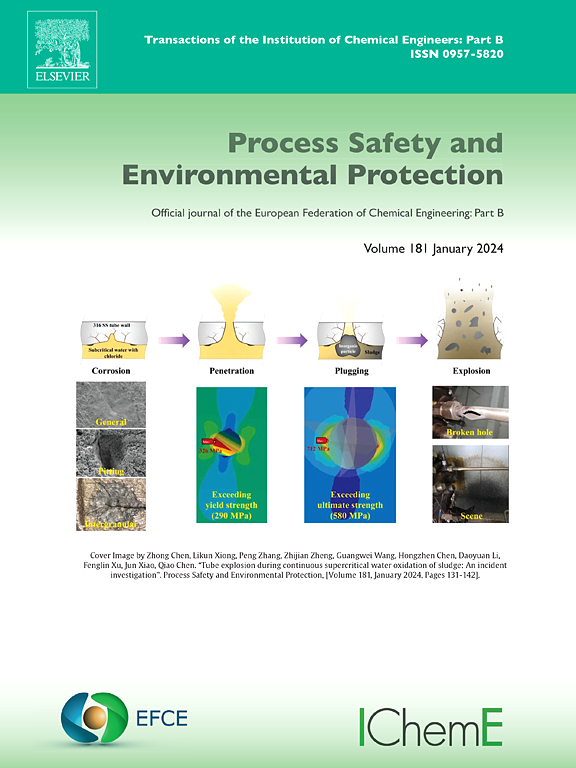Synergistic enhancement of electron transfer in the photocatalysis/persulfate-oxidation system for highly efficient norfloxacin degradation
IF 7.8
2区 环境科学与生态学
Q1 ENGINEERING, CHEMICAL
引用次数: 0
Abstract
The photocatalysis/persulfate-oxidation hybrid (PPOH) system is recognized as an effective approach for eliminating organic contaminants. Nevertheless, designing highly stable, high-performance catalysts remains an ongoing challenge. In this study, graphene quantum dots (GQDs)-loaded Fe-doped NH2-MIL-125 (Ti) (GxNM (Fe0.2Ti0.8)) are synthesized via a co-modification strategy for norfloxacin (NOR) degradation in PPOH. The introduction of Fe doping not only enhances visible light responsiveness but also provides activation sites for peroxydisulfate (PDS), facilitating the photogenerated carrier transfer in the metal-to-metal charge transfer (MMCT) process between Ti-O-Fe. GQDs incorporation further suppresses photogenerated carrier recombination. In the PPOH system, NOR degradation by G10NM (Fe0.2Ti0.8) achieves a rate of 80.1 % within 120 min, surpassing that of NH2-MIL-125 (Ti) by a significant factor of 5.24. Free radical trapping and electron paramagnetic resonance (EPR) experiments confirm that •O2-, h+ and SO4•- are the primary active species responsible for NOR degradation. The synergy of Fe doping and the unique electron transfer properties of GQDs accelerates electron transfer, thereby enhancing the catalytic efficiency. Moreover, the developed composite exhibits outstanding stability and recyclability, maintaining a NOR removal rate of over 70.3 % even after five cycles. This work opens up new avenues for applying modified metal-organic frameworks (MOFs) in antibiotic contaminants removal through the PPOH approach.
光催化/过硫酸盐-氧化体系中电子传递的协同增强对诺氟沙星的高效降解
光催化/过硫酸盐-氧化混合(PPOH)系统被认为是一种有效的去除有机污染物的方法。然而,设计高度稳定、高性能的催化剂仍然是一个挑战。在本研究中,通过共修饰策略合成了负载fe掺杂NH2-MIL-125 (Ti) (GxNM (Fe0.2Ti0.8))的石墨烯量子点(GQDs),用于在PPOH中降解诺氟沙星(NOR)。Fe掺杂的引入不仅增强了可见光响应性,而且为过硫酸氢盐(PDS)提供了激活位点,促进了Ti-O-Fe之间金属到金属电荷转移(MMCT)过程中光生载流子的转移。GQDs的掺入进一步抑制了光生载流子重组。在PPOH体系中,G10NM (Fe0.2Ti0.8)在120min内对NOR的降解率达到80.1%,比NH2-MIL-125 (Ti)的降解率高出5.24倍。自由基捕获和电子顺磁共振(EPR)实验证实,•O2-、h+和SO4•-是负责NOR降解的主要活性物质。Fe掺杂的协同作用和GQDs独特的电子转移特性加速了电子转移,从而提高了催化效率。此外,所开发的复合材料具有出色的稳定性和可回收性,即使经过5次循环,NOR去除率仍保持在70.3%以上。这项工作为通过PPOH方法将改性金属有机框架(MOFs)应用于抗生素污染物去除开辟了新的途径。
本文章由计算机程序翻译,如有差异,请以英文原文为准。
求助全文
约1分钟内获得全文
求助全文
来源期刊

Process Safety and Environmental Protection
环境科学-工程:化工
CiteScore
11.40
自引率
15.40%
发文量
929
审稿时长
8.0 months
期刊介绍:
The Process Safety and Environmental Protection (PSEP) journal is a leading international publication that focuses on the publication of high-quality, original research papers in the field of engineering, specifically those related to the safety of industrial processes and environmental protection. The journal encourages submissions that present new developments in safety and environmental aspects, particularly those that show how research findings can be applied in process engineering design and practice.
PSEP is particularly interested in research that brings fresh perspectives to established engineering principles, identifies unsolved problems, or suggests directions for future research. The journal also values contributions that push the boundaries of traditional engineering and welcomes multidisciplinary papers.
PSEP's articles are abstracted and indexed by a range of databases and services, which helps to ensure that the journal's research is accessible and recognized in the academic and professional communities. These databases include ANTE, Chemical Abstracts, Chemical Hazards in Industry, Current Contents, Elsevier Engineering Information database, Pascal Francis, Web of Science, Scopus, Engineering Information Database EnCompass LIT (Elsevier), and INSPEC. This wide coverage facilitates the dissemination of the journal's content to a global audience interested in process safety and environmental engineering.
 求助内容:
求助内容: 应助结果提醒方式:
应助结果提醒方式:


